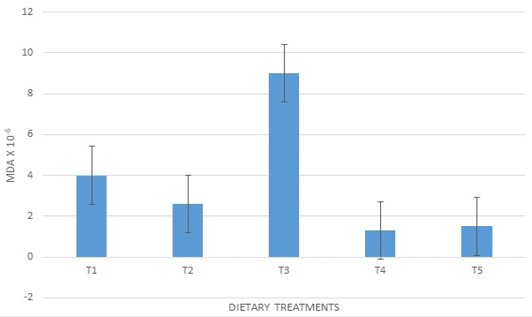Impact of Tithonia, Parkia and Synedrella Leaf Meals in Kit Rabbits’ Diets: Growth Performance, Carcass Indices and Meat Quality
Razaq Animashahun1, Funmilayo Okeniyi1, Olayinka Alabi1, Samuel Olawoye1, Precious Oluwafemi1, Princess Odhe1, Oluwatola Akintola1, Adedeji Animashahun2
1Department of Animal Science, College of Agricultural Sciences, Landmark University, P.M.B. 1001, Omu Aran, Kwara State, Nigeria; 2Department of Animal Breeding and Genetics, Federal University of Agriculture, P.M.B. 2240, Abeokuta, Nigeria.
*Correspondence | Precious Oluwafemi, Department of Animal Science, College of Agricultural Sciences, Landmark University, P.M.B. 1001, Omu Aran, Kwara State, Nigeria; Email:
[email protected]
Figure 1:
Lipid peroxidation of grower rabbits fed diets containing different leaf meals.
T1: Dietary treatment containing 100% Concentrate; T2: Dietary treatment containing 6 % Tithonia diversifolia leaf meal (TDLM); T3: Dietary treatment containing 6 % Parkia biglobosa leaf meal (PBLM); T4: Dietary treatment containing 6 % Synedrella nodiflora leaf meal (SNLM); T5: Dietary treatment containing 2 % TDLM + 2 % PBLM + 2 % SNLM, MDA: Malondialdehyde.















